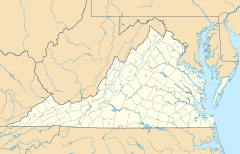Bacova Junction, Virginia facts for kids
Bacova Junction is a small, unincorporated community in Bath County, Virginia, in the United States. An "unincorporated community" means it's a place with people living there, but it doesn't have its own local government like a city or town. It's located about 2.9 miles (4.7 km) west of Hot Springs. Two important roads, Virginia State Route 615 and Virginia State Route 687, meet right in this community. In the past, Bacova Junction was very important for its timber industry, which means cutting down trees for wood.
Quick facts for kids
Bacova Junction
|
|
|---|---|
|
Unincorporated community
|
|
| Country | United States |
| State | Virginia |
| County | Bath |
| Time zone | UTC−5 (Eastern (EST)) |
| • Summer (DST) | UTC−4 (EDT) |
| ZIP codes |
24445
|
Contents
Discovering Bacova Junction's Past
Bacova Junction used to have a different name: Grose. There's an old house called Thornhill House, which was once known as Grose house. It's still standing today near the community, by Queen Springs and Cowardin Run.
Historic Homes and Plantations
Another important building in the area is the Warwickton plantation. A plantation is a large farm or estate, often with a big house. Judge James Woods Warwick built this plantation in the 1850s. Later, in the 1890s, Ron and Pam Stidham worked to restore the house, bringing it back to its original beauty.
Where is Bacova Junction?
Bacova Junction is located in Virginia. It's about 74.2 miles (119.4 km) southeast of Harrisonburg. As mentioned earlier, it's also 2.9 miles (4.7 km) west of Hot Springs. You can find it about 3.1 miles (5.0 km) north of Callison.
Roads and Elevation
The community is a meeting point for two state roads: Virginia State Route 615 and Virginia State Route 687. This means these roads come together right in Bacova Junction. The community sits at an altitude of about 550 meters (1,804 feet) above sea level.
Bacova Junction's Economy
In the past, Bacova Junction was an important center for the timber industry. This means that cutting down trees and processing wood was a big part of the local economy.
Timber and Transportation
The community was located along the Chesapeake and Ohio Railway. Railways were very important for moving goods, and this one helped transport timber from Bacova Junction. There were over 30,000 acres (12,141 hectares) of timberland in the area, providing a lot of wood for the industry.



